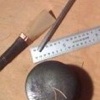Tuning
- From the Salt Lake Piping Club Reeds Page:
A brief 'note' on tuning:
Most types of bagpipe were created to play not only as a melody instrument, but also against their own set of drones. The drones, of course, produce a steady note or notes usually tuned to the bell (bottom) note of the chanter, or some ratio thereof. The problem that arises from playing against drones is that the notes played in an equal temperament scale do not correlate well and will sound out of tune. So chanters are commonly tuned to a just intonation scale which allows all notes to sound in tune with the drones.
One problem commonly observed in session groups is that some musicians will invariably be 'tied' to their electronic tuners - those little black boxes that tell them how close to pitch they are. However, if you use one of the commonly available tuners to tune the pipes, it won't work well because the common tuner is pitched to equal temperament, and not to just intonation.
As a result, it becomes highly difficult to know if you are in tune or not. You either need to spend a bit of money on a reliable cross temperament tuner that can be switched from equal to just, or you can simply use a hand chart to make note of how far 'off' your notes should appear when compared against an equal temperament tuner. The chart below illustrates these values and is a good starting point when tuning. The values given are in cents (100ths of a semi-tone) sharp or flat using an equal temperment tuner calibrated to A = 440Hz, and may be assumed true for both upper and lower octaves:
Back D - even 0.00
C# - minus 11.73
C Nat. - minus 3.91
B - minus 15.64
A - plus 1.96
G - minus 1.96
F# - minus 13.69
E - plus 3.91
Bottom D - even 0.00"
- Just Intonation Explained, by Kyle Gann
1. How Fractions Denote Pitches
2. How to Play with Intervals
3. How Is This Different from Our Normal Tuning?
4. What Does Music in Pure Intervals Sound Like?
An Introduction to Historical Tunings - a whole other subject
Anatomy of an Octave: a reference chart of several hundred intervals within an octave
My Idiosyncratic Reasons for Using Just Intonation (as opposed to high-number equal temperaments)
- The Just Intonation Network
News, a journal, a primer and books about just intonation
